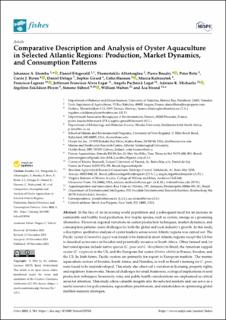| dc.contributor.author | Litembu, Johannes A. | |
| dc.contributor.author | Fitzgerald, Daniel | |
| dc.contributor.author | Altintzoglou, Themistoklis | |
| dc.contributor.author | Boudry, Pierre | |
| dc.contributor.author | Britz, Peter | |
| dc.contributor.author | Byron, Carrie J. | |
| dc.contributor.author | Delago, Daniel | |
| dc.contributor.author | Girard, Sophie | |
| dc.contributor.author | Hannon, Colin | |
| dc.contributor.author | Kafensztok, Marcia | |
| dc.contributor.author | Lagreze, Francisco | |
| dc.contributor.author | Legat, Jefferson Francisco Alves | |
| dc.contributor.author | Legat, Angela Puchnick | |
| dc.contributor.author | Michaelis, Adriane K. | |
| dc.contributor.author | Pleym, Ingelinn Eskildsen | |
| dc.contributor.author | Sühnel, Simone | |
| dc.contributor.author | Walton, William | |
| dc.contributor.author | Strand, Åsa | |
| dc.date.accessioned | 2023-12-01T10:00:26Z | |
| dc.date.available | 2023-12-01T10:00:26Z | |
| dc.date.created | 2023-11-30T09:23:30Z | |
| dc.date.issued | 2023 | |
| dc.identifier.citation | Fishes. 2023, 8 (12), 1-19. | |
| dc.identifier.issn | 2410-3888 | |
| dc.identifier.uri | https://hdl.handle.net/11250/3105563 | |
| dc.description.abstract | In the face of an increasing world population and a subsequent need for an increase in sustainable and healthy food production, low trophic species, such as oysters, emerge as a promising alternative. However, regional variations in oyster production techniques, market dynamics, and consumption patterns create challenges for both the global and local industry’s growth. In this study, a descriptive qualitative analysis of oyster markets across seven Atlantic regions was carried out. The Pacific oyster (Crassostrea gigas) was found to be farmed in most Atlantic regions except the US but is classified as invasive in Sweden and potentially invasive in South Africa. Other farmed and/or harvested species include native species (C. gasar and C. rhizophorae) in Brazil, the American cupped oyster (C. virginica) in the US, and the European flat oyster (Ostrea edulis) in France, Sweden, and the US. In Irish farms, Pacific oysters are primarily for export to European markets. The marine aquaculture sectors of Sweden, South Africa, and Namibia, as well as Brazil’s farming for C. gasar, were found to be underdeveloped. This study also observed a variation in licensing, property rights, and regulatory frameworks. Financial challenges for small businesses, ecological implications of seed production techniques, biosecurity risks, and public health considerations are emphasized as critical areas for attention. This study offers valuable insights into the selected markets and can serve as a useful resource for policymakers, aquaculture practitioners, and stakeholders in optimizing global shellfish industry strategies. | |
| dc.description.abstract | Comparative Description and Analysis of Oyster Aquaculture in Selected Atlantic Regions: Production, Market Dynamics, and Consumption Patterns | |
| dc.language.iso | eng | |
| dc.title | Comparative Description and Analysis of Oyster Aquaculture in Selected Atlantic Regions: Production, Market Dynamics, and Consumption Patterns | |
| dc.title.alternative | Comparative Description and Analysis of Oyster Aquaculture in Selected Atlantic Regions: Production, Market Dynamics, and Consumption Patterns | |
| dc.type | Peer reviewed | |
| dc.type | Journal article | |
| dc.description.version | publishedVersion | |
| dc.source.pagenumber | 1-19 | |
| dc.source.volume | 8 | |
| dc.source.journal | Fishes | |
| dc.source.issue | 12 | |
| dc.identifier.doi | 10.3390/fishes8120584 | |
| dc.identifier.cristin | 2205980 | |
| dc.relation.project | Nofima AS: 12585 | |
| dc.relation.project | EC/H2020/818173 | |
| cristin.ispublished | true | |
| cristin.fulltext | original | |
| cristin.qualitycode | 1 | |
